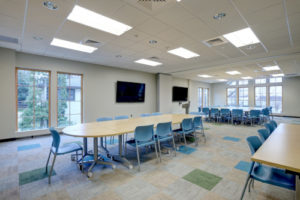As a parent, the excitement surrounding the prospect of returning to in-person teaching and learning at our children’s school is welcome. It is also pervasive nationwide, as parents everywhere begin to think about a resumption of familiar routines, whether their children are in grade school, high school, or off to college.
For some time to come, however, airborne contagions will remain at the forefront of our collective thoughts. Until the pandemic is visible in the rearview mirror, so to speak, facilities teams, administrators, and school boards must continue to assess academic buildings’ ventilation to ensure student, faculty, and staff safety.
As of this writing, the CDC has released new guidelines for social distancing in classrooms, reinforcing the need for masking and other protections while allowing for a distance of three feet between desks instead of six. Only a few weeks earlier, a special report from The New York Times took a look at classroom ventilation, with the authors and editors partnering with leading schools of public health as well as engineering consultants. Their analysis of short-term strategies—opening a window regardless of the weather, with or without a box fan placed in the opening—suggests that such interventions can indeed reduce any remaining risk of transmission.
This is all very encouraging. Speaking as both an architect and a parent, students need to be in an environment other than the home when learning. (The same goes for teachers, who find their jobs are much more difficult when performed remotely.) But The New York Times report neglects a critical area of discussion: cost.
COVID-19 has already created serious economic challenges for universities and public school districts—the former struggling with enrollment and plummeting tuition income, the latter impacted negatively by the effect of an overall economic downturn on state and local tax revenues. Opening a classroom window can increase heating and cooling bills significantly… in many cases by double-digit percentages. This will exacerbate existing financial woes and force difficult choices.
The basic thinking behind the report is correct, of course. The goal is indeed to increase the amount of fresh air circulating in the learning environment. The problem is that we have become increasingly dependent on centralized mechanical ventilation and climate control systems to regulate not only cubic feet per minute (CFM) of air flow but also temperature and humidity. Many of us in the building profession would like to see a world of built environments that are far less dependent on controlled air. Employing principles of passive design, a school or university building could take advantage of the natural climate and weather patterns to increase the amount of air flow, bolstered by low-impact technology such as heat-recovery mechanisms.
But we must address the world as it is, and most of our nation’s academic buildings, some of which are more than a century old, are not designed to support the needed levels of air flow without using significantly more energy than they can likely afford—an amount that is also measurably contributing to carbon-related climate change.
Policymakers, institutional stakeholders, school district leaders, and others must begin to formulate plans that address short-term needs while considering longer-term solutions. The long view is also critically important because, while it’s sad and a little scary to think about, this may not be the last pandemic of our lifetimes. Failing to consider the possibility of future public health crises could come back to haunt us sooner than we’d like to admit.
In working with decisionmakers in K-12 and higher education facilities, industry experts advocate for comprehensive approaches combining opening windows and other short-term solutions (entry-point temperature checks, transparent shields between desks, etc.) that will help schools to reopen safely and at capacity. A fan in a window is fine, but relying on separate unit ventilators and heating/cooling units for each room should be a non-starter. Centralizing HVAC systems is essential to whole-building efficiency and performance, and many academic facilities are good candidates for retrofits that improve ventilation and balancing performance with energy demand.
There is also a movement among architects in the academic sector to completely rethink the enclosed classroom. Open plans with acoustic schemes for creating separation have been successfully incorporated into public schools and college campuses, albeit with revamped pedagogy in some cases. While this may not be an option for an existing building, it can be considered for future construction projects.
We also have to rethink finishes and surface materials. In the years to come we are likely to see more aggressive cleaning schedules with combatting viral transmission in mind. More durable materials will be necessary for standing up to frequent cleanings.
Approaches to school dress that account for the changes in season should also be a part of the conversation, with the goal of reducing demand on HVAC systems—in other words, students wear sweaters in winter to reduce energy consumption for heating. For warmer seasons and climates, it would also be wise to consider more classroom time outdoors and building outdoor spaces to accommodate this activity. There is a growing body of evidence showing that more time spent outdoors correlates to improved academic performance.
There are other considerations, including integrated building controls, air treatment methods, and more. But the goal of increasing airflow without spiking energy costs should remain the same regardless of the particular solution. Our faculty and students have had a very tough time during the pandemic; we should do everything we can to make sure they have safe, healthy spaces in which to carry on the important business of teaching and learning.

